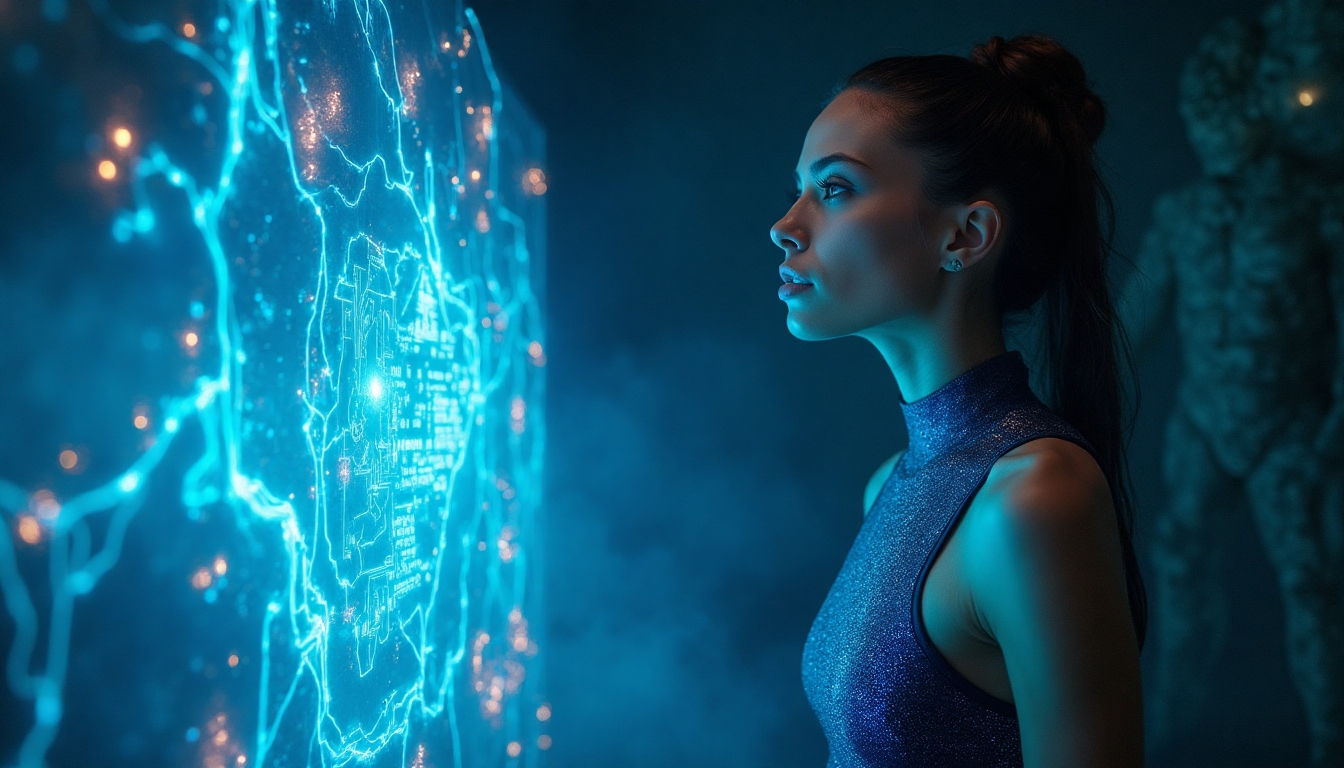Amid the smoky haze of Cold War tensions in the late 1950s, American reconnaissance efforts reached for the stars—literally. Sophia Novak, a 32-year-old physicist with raven-black curls and piercing hazel eyes, wandered the labyrinthine hallways of Langley’s headquarters late into the night, trailing the smoke of her colleague's lit Pall Mall cigarettes. Unflinchingly brilliant, Sophia had already made her mark as one of the architects of the Corona Satellite Program.
Clad in a tailored, olive-green pencil skirt and white blouse accented with lace trim, her outfit reflected both the conservatism of her time and her unapologetic intellect. Her modest kitten heels echoed against the cold, tiled CIA floors. Her figure was slight, but her presence carried weight. She had the stern gaze of someone who could simultaneously calculate orbital mechanics and charm a room full of military suits doubting her credentials.
Chapter 1: Eyes in the Sky
The room was abuzz with chatter early one morning in March 1959 when the photographs came in. High-altitude surveillance from Corona’s test flights—a stunning, grainy shot of Soviet Central Asia. Every official in the room leaned over vast tables gleaming with scattered photographs. Sophia, armed with a magnifying glass, inspected the image so closely one might think she was interrogating the photo. She tucked a loose strand of hair back behind her ear: the mountainous contours of Soviet regions were visible, glistening, cold—but it wasn’t the shape of terrain Sophia noticed first.
A secondary layer of information sat hidden. The play of light made her heart leap. “Here,” she whispered softly with her accent—her Czech origin betraying roots shaped in Eastern Europe but hardened on American ideals. “There’s more here. Water resources… erosion patterns?” The irony wasn’t lost on her: images meant to predict war strategies inadvertently uncovered Soviet irrigation lakes drying out at alarming rates. It was Earth herself, whispering a different kind of secret through their lenses.
Chapter 2: The Senator’s Intervention
Fast forward three decades to the early 1990s. Sophia, now silver-haired but still sharp as a tack, had found herself displaced into semi-retirement. The Cold War’s thaw put most espionage personnel out of work. Her hands, once steady, trembled faintly as she wrote in longhand despite the novelty of email she grimaced at.
It was during her last public visit to Capitol Hill, as an advisor behind thick lenses and a silk scarf draped over her shoulders, that she met Senator Daniel Crowley. Where Sophia was quiet brilliance, Daniel was a storm with clean-cut confidence and sleeves always rolled up over muscled forearms that seemed meant for fixing things rather than drafting legislation. He’d go from shaking farmers’ hands in the Midwest to drinking scotch across mahogany desks with Pentagon brass, embodied in tailored suits designed less for vanity than utility. His laser-sharp charisma couldn’t be ignored.
And he saw, through Sophia’s faintly waning years, the blade of brilliance that still shone sharp within. “Dr. Novak,” he addressed her respectfully over hearings about “redeployment of Space Resources,” a code-phrase looping back to Corona-era satellites. He had caught somewhere in her notes the implication of long-hidden environmental data.
“You’re suggesting… these satellites can do what? Redefine how we track climate globally?” His voice half-challenged her, half-invited expertise rarely appreciated outright in hearing panels until—thank God—this NPC-grade procedural oversight... pivoted forward.
Chapter 3: Sabotage or Repurpose?
Sophia’s eyes glimmered with a spark that hadn’t been there in years. “Senator Crowley, I’m suggesting these satellites have been tracking more than just military movements. The data we've been collecting could reshape how we understand the environment, how we respond to it. It’s all there—decades of observations we never thought to analyze this way.”
Crowley leaned back, his brow furrowed, his mind turning the gears of possibility. “So, you’re saying the tools that once kept our enemies in check could now save the planet?”
Sophia nodded, her voice calm but firm. “Exactly. But we need access to those archives, and we need it now. Before they’re buried or, worse, destroyed by bureaucrats who think the Cold War is ancient history.”
The Senator’s jaw tightened. He knew the kind of resistance they would face. The old guard wouldn’t easily repurpose their tools of espionage into instruments of preservation. It wasn’t just a battle of politics—it was a battle of legacy.
“We’ll need to move quietly,” Crowley said. “If we make too much noise, someone will make sure those files disappear.”
Sophia smiled faintly. “I’ve operated in shadows my entire life. Let’s go save the world, Senator.”
Chapter 4: The Lost Archives
They worked relentlessly over the next few weeks, a strange partnership forged by urgency and mutual respect. Crowley used his political clout to dig into decommissioned programs, while Sophia combed through dusty archives, decoding forgotten files. They pieced together a mosaic of environmental changes that had been hiding in plain sight—satellite images revealing deforestation, rising sea levels, and the retreat of glaciers.
One night, in a dimly lit office cluttered with maps and coffee cups, Sophia made a breakthrough. “Here,” she said, pointing to a series of grainy photos taken over the Siberian tundra. “Look at the ice shelf. These images show it receding over the decades. The rate is accelerating.”
Crowley stared at the images, the weight of the revelation sinking in. “We’ve had this information for years and did nothing.”
“It was never meant to be found,” Sophia replied. “But now it’s our responsibility.”
Chapter 5: A New Mission
With the evidence in hand, they prepared for one final showdown. Crowley arranged for a closed-door hearing, inviting key scientists, policymakers, and a few trusted journalists. Sophia, dressed in a simple black dress and her ever-present silk scarf, stood at the podium.
“These images,” she began, holding up a stack of satellite photos, “are more than relics of a bygone era. They are a warning—a record of changes we can no longer ignore. The same technology that once protected us from our enemies can now protect us from ourselves. But only if we act.”
Her voice, though aged, was steady. “We have a choice: let this knowledge rot in forgotten archives, or use it to preserve our future.”
The room was silent. Then, slowly, the applause began. First a few hands, then a wave of approval. Crowley met her eyes across the room and nodded. They had done it.
Epilogue: The Legacy of the Skies
In the years that followed, the repurposed satellite data became instrumental in shaping global climate policy. Sophia Novak’s name was etched into history, not just as a Cold War scientist but as a pioneer of environmental science. Senator Crowley continued to fight for transparency and action, his sleeves perpetually rolled up, ready to tackle the next challenge.
Sophia, now fully retired, would sometimes look up at the night sky, tracing the faint paths of satellites she helped launch. She smiled, knowing that even in the darkest times, there were always eyes in the sky watching, waiting to reveal the truth.
And sometimes, those eyes belonged to people who dared to believe that the tools of war could become the seeds of hope.
The Source...check out the great article that inspired this amazing short story: When the CIA Secretly Spied on Climate Change 🤫
Disclaimer: This article may contain affiliate links. If you click on these links and make a purchase, we may receive a commission at no additional cost to you. Our recommendations and reviews are always independent and objective, aiming to provide you with the best information and resources.
Get Exclusive Stories, Photos, Art & Offers - Subscribe Today!
























Post Comment
You must be logged in to post a comment.